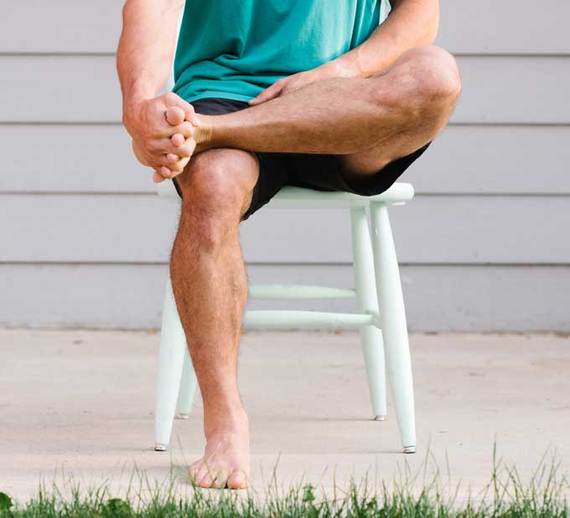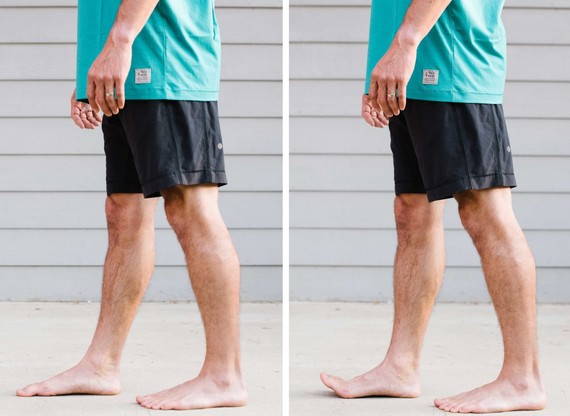By: Pete Egoscue
Fascia are connective tissue, and they are found throughout our bodies at various subcutaneous levels. The knee bone is connected to the thigh bone, and on and on, and that song ought to be titled "Ode to Fascia." Plantar fascia are the tissue that connect our heels to the rest of our feet, and plantar fasciitis is an inflammation of that heel fascia. For any of you who have had it, you know it hurts like the dickens, especially those first steps in the morning or after you've been off of your feet for a while.
Why do people get it? According to the medical world, there are a handful of contributing factors, some of them even contradictory. People with flat feet get it, but so do people with high arches. Joggers who jog too much get it, but so do couch potatoes who sit too much. When it comes to this painful condition, the one thing everyone seems to agree on is that it is caused by the foot being under tremendous stress.
Fair enough, but why is that stress causing this painful symptom? After all, joggers jogged thousands of miles before the symptom appeared, so what changed? Besides, both heels on the jogger have traveled the same distance, so why is just one heel feeling the pain? And why on earth is the couch potato experiencing the pain?
There is no consensus, and if you don't understand the symptom, it's very difficult to offer a proper prescription. Most doctors end up treating plantar fasciitis with an injection like cortisone or orthotics to offer support, but the problem with these prescriptions is that they don't solve the problem as much as they just silence the symptom.
Pain is the body's way of telling you there's a problem, a message we need to listen to rather than squelch, and barring trauma, the site of the pain is rarely the source of the problem. Therefore, to silence that screaming racket that your plantar fascia are making is to ignore the underlying problem, so nothing is going to get solved. But it's even worse than that. When you offer support in the form of orthotics, you are actually weakening the afflicted area which, over time, will cause subsequent problems, not only in that area but throughout other parts of the body as well. Remember, the body is a single unit, and compensating in one area will negatively impact other areas. It's inevitable. The knee bone is connected to the thigh bone, after all.
So yes, stress is the problem, but why? The short answer is the position of the foot.
There are three arches in our feet -- the longitudinal lateral arch (which goes the length of the foot along the outside), the longitudinal medial arch (which goes the length of the foot along the inside) and the transversal arch, which is that big concave in the middle most people think of when they think of foot arches.
All babies are born flat-footed, and they develop these arches through their infant and toddler years, provided that development isn't interrupted. (Learn more about the surprising thing affecting kids' physical development here.) The design of those arches allows the foot to move in every direction to enable whatever it is we might do -- stand, walk, run forward like a sprinter, run backwards like a defensive back, jump and spring like a volleyball player, or shuffle step sideways like a tennis player. In addition, that design is such that no matter the action, the weight of the load is evenly distributed across the entire foot.
All of this is predicated on the idea that, when standing completely still, the foot is naturally pointed straight ahead. But because of interrupted development, sedentary lifestyles, and numerous other contributing factors, our bodies get misaligned and our joints get deviated, as can be seen by a foot pointing out. When this happens, the weight during activity is no longer being evenly distributed across the foot, and sometimes, too much weight is being placed on that heel, thus leading to plantar fasciitis.
The good news is that there is a solution. If your joints are misaligned, and your feet are pointing out, you can realign them. In addition, if your arches have fallen, you can raise them again; that's right, your flat feet don't have to be. Our bones do what our muscles tell them to do; in infancy and toddlerhood, the actions of crawling and learning to walk compelled our foot muscles to tell our foot bones what they needed to hear in order to develop arches. With proper alignment exercises, that process can be duplicated in adulthood.
But that requires a full realigning of the body over the course of a few months. For now, here are a couple quick exercises that will bring temporary relief, the latter of which was given to me by the late Vladimir Yanda, a pioneering genius in the field of muscular symmetry and postural alignment.
With bare feet, sit in a chair with one leg crossed over the opposite knee. Interlace fingers between the crossed foot's toes. Roll your pelvis forward to arch your lower back. Try to remain sitting straight throughout the entire exercise. First, using your hand, circle the foot outward (counter-clockwise), manipulating the toes purposely. Next, using your hand, circle the foot inward (clockwise), manipulating the toes purposely. Next, using your hand, flex and point your foot/toes using the hand to create the movement. Repeat these movements for one minute, then switch legs and repeat.
Stand with your feet hip width apart. Bring your right foot forward so that your right heel is in line with the toes of the left foot.Make sure both feet are pointing absolutely straight, and make sure your weight is evenly distributed in both feet. In this position, curl the toes of the right foot up off the floor using the muscles on the top of your foot. Try to spread them apart as you pull them off the floor. Do not let the ball of the foot lift off the floor, only lift the toes. Next press the toes into the floor without lifting the heel. The movement is elongating the toes as you press them down, not curling the toes. The arch of your foot will produce this motion, the arch will probably increase. Do three sets of 20 reps.
Remember, the body wants to function properly, and all pain, such as plantar fasciitis, is nothing more than its way of telling you that it currently isn't. Align your body, and I promise those plantar fascia will stop that painful racket.
Photos by Caitlin Steuben
Known as the Father of Postural Therapy, Pete Egoscue has helped relieve thousands of people from their chronic pain, including many of the world's leading athletes. For more information on Pete and any of his 25 clinics worldwide, go to egoscue.com. Find more articles like this one on Sonima.com.


